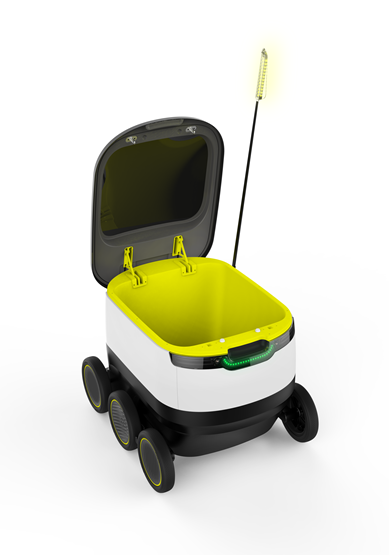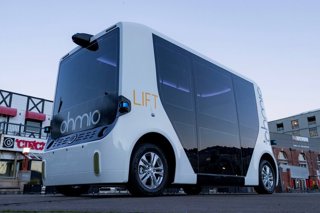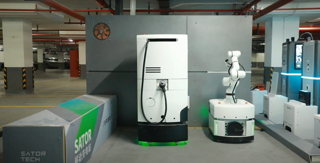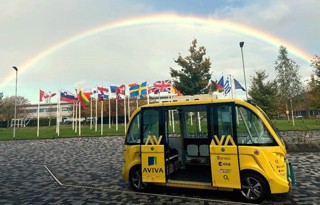A fleet of self-driving robots is poised to disrupt the last-mile delivery market by replacing the vehicles and drivers the industry currently employs.
Industry estimates suggest that more than 40,000 delivery drivers are employed in the UK thanks, in part, to the boom in online sales.
Consumers spent £52.2 billion online in the UK last year – 16.2% more than the £44.97bn they spent in 2014 – and expenditure is expected to reach £62.7bn in 2020.
Meanwhile, the domestic parcels market is now worth some £8.9bn pounds a year, with the total number of physical deliveries generated by online orders predicted to grow by 40%, from 890 million in 2013 to 1.25bn in 2018.
It is a challenging and fast-growing market, with home deliveries reaching a peak in the run-up to Christmas. This seasonality forces courier companies to flex their fleets in order to meet the increased demand.
Yodel, which has a permanent fleet of almost 2,500 vehicles, recruited more than 800 directly employed drivers and signed up around 3,000 owner-drivers, with their own vans, to meet demand last Christmas.
The growth in online shopping – driven by the proliferation of smartphones and tablets – has also helped fuel van registrations. Figures from the Society of Motor Manufacturers and Traders (SMMT) showed they were up 1.2% in the first quarter of 2016, after more than 370,000 units were registered last year.
However, the movement of goods between transport hub and delivery address, the so-called last mile, is expensive and can account for up to 28% of total delivery costs.
It is a tough market defined by tight margins, with retailers and logistics providers under pressure to provide an efficient delivery in terms of speed, price, service and quality.
City Link, one of the UK’s biggest couriers, paid the ultimate price and went into administration in 2014, with the loss of more than 2,700 jobs.
“The problem with last-mile is we are delivering stuff to our homes the same way they did 100 years ago,” said Allan Martinson, chief operating officer of tech start-up Starship Technologies. “We put it on expensive vehicles and we use the most expensive asset in the world – a human – to drive.
“The philosophy at Starship is to put wheels on packages, goods and groceries, and let them drive themselves to you.”
Set-up by Skype co-founders Janus Friis and Ahti Heinla in 2014, Starship Technologies’ aim is to fundamentally reshape how goods are shipped and delivered, in much the same way that Skype transformed the telecoms market.
“Our robots are a totally new class of device that will provide a combination of low cost and convenience, with less congested streets and zero emissions,” said Heinla, chief executive officer of Starship Technologies.
The company’s self-driving delivery robot has been billed by Business Insider as one of the five most anticipated technology products of 2016.
Resembling a coolbox on wheels, the autonomous, electric six-wheeler trundles along the pavement at just under 4mph – a brisk walking pace. It navigates by using a combination of visual information in pre-mapped areas, GPS and an inertial measurement unit (IMU), which enable its position to be measured within an accuracy of 2cm.
An ultrasonic obstacle detector gives it a detection range of 10m while in motion, and 200m when still, and it can climb a 15cm kerb. It is also lightweight; unladen it weighs 15kg and it has a cargo capacity of 10kg.
The robot fleet is monitored by human remote controllers who can take over control at any time, and can communicate with anybody it encounters via a built-in microphone and speaker.
Martinson envisages a delivery service where goods and packages are delivered by van to a local business or a Starship hub, which is home to a fleet of robots able to deliver within a two-mile radius. The customer then calls up a delivery time that is convenient to them via an app which, like Uber, shows them where their delivery is in transit relative to their address. The app allows access to the locked compartment where goods are stored once it reaches its end destination.
It is envisaged as a platform-as-a-service approach. Businesses can either pay for the service on a per-delivery basis or buy robots and pay for associated services, such as maintenance and operators (all robots are monitored by Starship operators at least 1% of the time; they are 99% automated). Its ultimate aim is for each delivery to be less than £1. Robot manufacturing costs are in the single-digit thousands, but Starship says this will fall with full-scale production.
“It’s safe and secure,” Martinson told delegates at the Connected Fleets Europe conference in Amsterdam. “It is fitted with nine cameras and an alarm, and it can detect when it has been lifted. We can guarantee that you will be seen, you will be filmed and you will be on YouTube by the evening.”
How people interact with the robot is a serious point. They are being tested in the US, Estonia, and London, and have already clocked-up 3,500 miles and interacted with 110,000 people. “That’s important, because most of our testing today is about social acceptance,” said Martinson.
The sector is no stranger to such innovation. Amazon has tried to mitigate against costly last-mile deliveries by taking ‘click and collect’ to a new level, with Amazon Locker and Pass My Parcel services.
It has also embraced the idea of drone deliveries. Its Prime Air concept aims to deliver packages weighing up to 2kg in 30 minutes or less, using small drones.
However, faced with a tough regulatory environment, both here and in the US, and various technical hurdles still to overcome, Amazon admits that “putting Prime Air into service will take some time”. In the meantime, it has been working with DHL Parcel and Audi to tackle the last mile.
They have developed a system which enables delivery direct to the boot of a customer’s car called ‘Audi connect easy delivery’. The courier receives a digital access code for the boot of the customer’s vehicle, which can be used one time only for a specific period of time.
DHL Parcel is providing the dispatching service in a pilot project and development partner Amazon is the first online retailer to offer customers delivery directly to their car’s boot. Audi connect easy delivery customers will also be able to send letters and parcels from their own car in the future.
The Audi initiative would at least ensure goods are successfully delivered at the first time of asking, but Starship Technologies believes its approach can cut costs further.
Martinson says the mathematics of last mile is simple. “It’s the human labour, vehicle and overheads, divided by the number of deliveries,” he said.
The self-driving delivery robot removes the human labour element involved in last-mile deliveries, while also reducing the costs associated with vehicles and their overheads, which Starship Technologies claims can cut current shipment costs by up to 93%.
Under the delivery-bot’s bonnet

Software 99% autonomous, with navigation based on visual information in pre-mapped areas, GPS and an inertial measurement unit (IMU) giving its position within 2cm accuracy.
Body Enclosed in a durable plastic shell, with a cargo lid that employs an electromechanical lock. LED lights on the front and rear. Unladen weight of 15kg and a cargo capacity of 10kg.
Drivetrain Six brushless electric motors power six wheels which turn according to a skid-steer system similar to that used by a tank. Can climb a 15cm kerb and travel at around 4mph, with a stopping distance of 30cm.
Sensors Nine cameras, an ultrasonic obstacle detector that has a detection range of 10m while in motion and 200m when still, and time-of-flight cameras which capture the entire scene with a pulse of light.
Communications Speakers and microphone.






















Login to comment
Comments
No comments have been made yet.